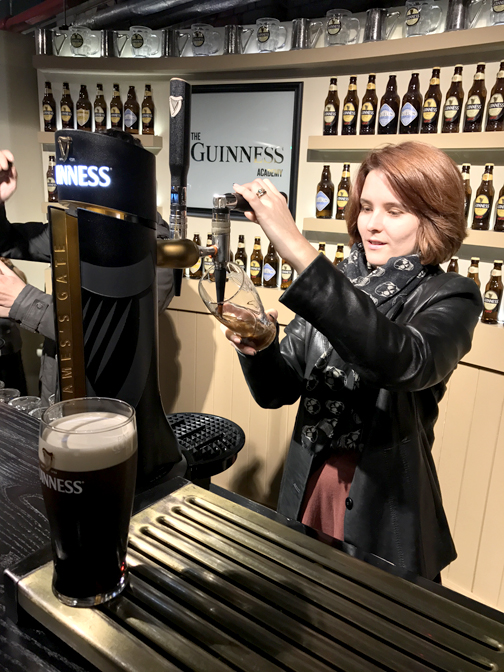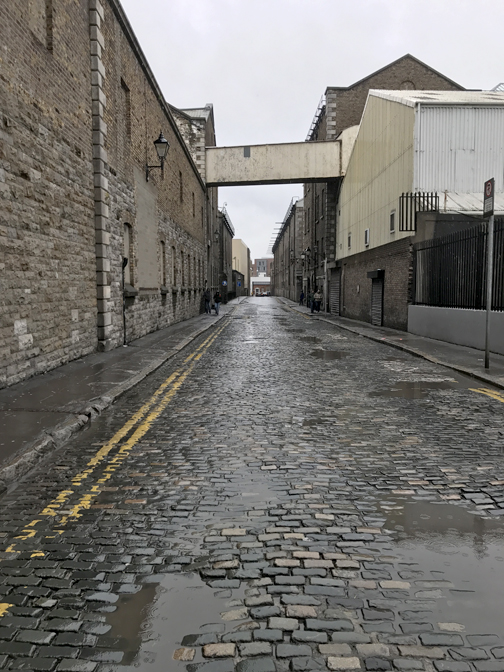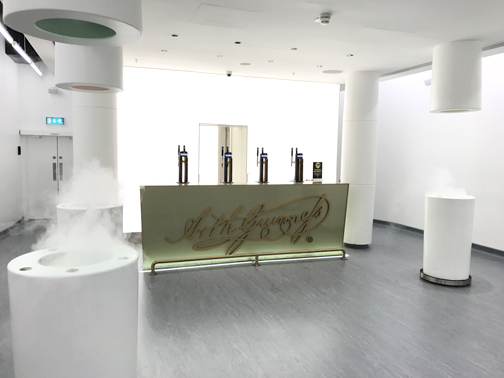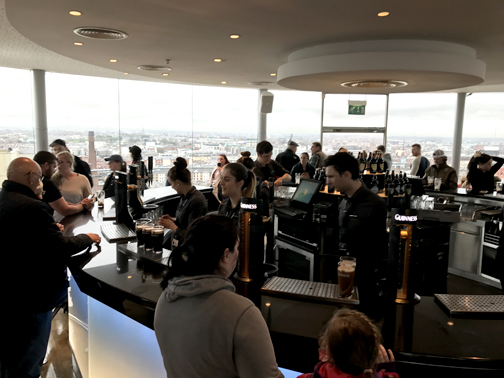The Real Drink of the Irish: Guinness

Sabrina Shelton learns to pour the ‘Proper Pint’
By Charly SHELTON
hen Americans think of Ireland, thoughts are usually of leprechauns, four leaf clovers, pots of gold and green beer, as is evidenced by the crowds of amateurs out on St. Patrick’s Day in their 99 Cents Store attire. These are not quite real Irish. In Ireland, leprechauns are the old gods that predated Christianity and are bitter about losing their seat, so they go around pulling seriously mean pranks on unsuspecting people. Clovers are the symbol of Ireland and are a popular food there but it’s the three-leaf variety as four leaf clovers are a rare genetic abnormality. The caches of gold are actually commonplace; they are not stored in pots, but rather were buried in sacks by Viking raiders and settlers as a hoard of treasure, with more being discovered all the time. And green beer is almost non-existent, kept only in a few bars for the desperate tourist. The real drink of the Irish people is Guinness.

There are many kinds of beer available to order across the country, but if one were to walk into any pub and say, ‘Give me a beer,’ you will get a Guinness. If you ask for a pint of the black, you get a Guinness. Sometimes if you order something else entirely, you’ll still get a Guinness. The famous posters of animals advertising Guinness are all over the country – put up like wallpaper in pubs, painted on the outside of buildings as murals, alluded to with the toucan mascot on products in almost every shop that carries souvenirs. Guinness is less a beverage and more a symbol of national unity, shipped out to be enjoyed across the world. The symbol of Guinness, aside from its zoo animal mascots, is the harp. It is the harp of Celtic hero and king Brian Boru, which was adopted as the official logo in 1862, when it was printed along with the word Guinness and the signature of Arthur Guinness on the label of the first bottle ever produced. In 1867, the harp was trademarked by Guinness and, in 1922 when the Free Irish State wanted to use it for its logo, it had to be turned around the other way to differentiate. The symbol for Guinness is literally the same thing as the symbol for the country.

With such a love and connection between Guinness and the Irish people it stands to reason that when visiting Dublin, the birthplace of Guinness, there should be a monument to this most incredible drink. This is the Guinness Storehouse. It is part brewery tour, part history museum, part tasting bar and all impressive. Whether it’s the self-guided tour or the private guided experience, you will learn something new.
I was invited to take the guided tour and I think it’s the way to go. While you can get the full story on a self-guided tour of the seven-story experience, it’s nice to have a Guinness expert there to answer all the burning questions you’ve ever had about the black.

For example, in the section on the advertising posters that John Gilroy did with the zoo animals, some of them say “Guinness is Good For You” or where there is a man carrying a horse in a cart or lifting giant steel girders, and it says “Guinness for Strength,” one must ask if that is true. Having a guide there to tell you that “Yes you should have a Guinness or two every single day, Charly” is helpful. (My wife keeps insisting that’s not what she told us, but that’s what I heard.)
From the interesting tidbits learned in the historical museum, to the Guinness tasting bar with regionally specific brews served around the world, to the pouring academy where you can be trained and certified to pour the “Proper Pint” of Guinness (a process that utilizes a special tap head and takes 119.5 seconds), this is a visitors center unlike any other in the world. And the whole tour ends with a complimentary pint of the black stuff in the Gravity Bar on the seventh floor.
At nearly 150 feet up, this bar affords 360° views of the whole city of Dublin, making for the perfect ending to the most incredible brewery tour in the world.
When visiting Dublin, this is the top attraction to see. There are other great places to visit, like the General Post Office (GPO) where the Easter Rising rebellion of 1916 was staged, the Kilmainham Gaol where prisoners from hundreds of years of insurrection were held and executed, and the National Museum of Archaeology, which houses many of those aforementioned Viking hoards and other ancient treasures, but no place in Dublin is as much fun as the Guinness Storehouse experience. For more info, visit http://guinness-storehouse.com.
